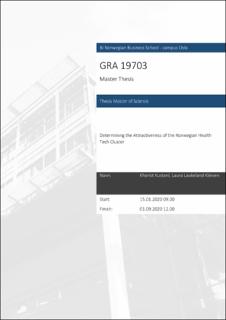Determining the Attractiveness of the Norwegian Health Tech Cluster
Master thesis

View/
Date
2020Metadata
Show full item recordCollections
- Master of Science [1621]
Abstract
With the rising societal challenges we are facing, health tech is getting an
increasingly central role in battling them. Yet, the industry remains as unknown for
many. The strengthened centrality has led to an establishment of several national
and international health tech clusters, among them in Norway.
The purpose of the following study has been to investigate how the Norwegian
health tech cluster scores on the various dimensions presented in The Emerald
Model. The findings have been derived with the intention to compare them to the
2011 study by Amir Sasson, to determine whether, and how, the cluster has evolved
in relation to the state presented by Sasson.
Through the use of in-depth quantitative data, the analysis revealed that the
Norwegian health tech cluster has positively developed on several dimensions of
The Emerald Model. In particular, the findings revealed that the cluster has
improved significantly on cluster attractiveness and knowledge dynamics. The
development in cluster attractiveness is mainly due to the strengthened value
creation of the firms in the cluster, as well as the regional proximity of their
location. Knowledge dynamics has been positively affected by the activities and
initiatives that the cluster organization, Norway Health Tech has initiated over the
last decade. However, the cluster is yet to transition from emerged to developed,
mainly as a result of two strong challenges: The structural barriers connected to the
lack of a national market for health tech products and services, and the absence of
competent owners and private capital. Specific recommendations directed towards
the cluster firms and the public institutions have been presented to somewhat help
overcome the challenges.
The related strengths and limitations of the study are thoroughly discussed, in
addition to presenting possible areas to further investigate in potential future
studies.
Keywords: Cluster, cluster attractiveness, diagnostic, global knowledge hubs,
health tech, health ICT, medtech, specialized subcontractors, The Emerald Model
Description
Masteroppgave(MSc) in Master of Science in Business, Strategy - Handelshøyskolen BI, 2020